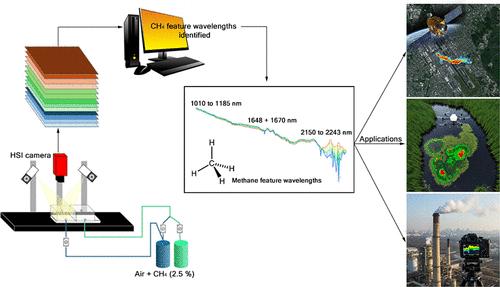利用短波红外高光谱成像定量甲烷浓度的特征波长:受控条件研究
IF 6.7
1区 化学
Q1 CHEMISTRY, ANALYTICAL
引用次数: 0
摘要
甲烷(CH4)是一种重要的温室气体,准确量化其浓度对于解决气候变化问题至关重要。本研究在受控条件下确定短波红外(SWIR)区域内可用于高光谱成像(HSI)定量测定CH4的潜在光谱区域或波长。这项研究还验证了目前用于遥感的波长的效率。采用恒定CH4流速的玻璃容器采集不同CH4浓度(N = 18;0 - 2.5%甲烷)。偏最小二乘回归(PLSR)使用266个波段(1010-2495 nm)进行训练。回归系数和PLS权重被用来识别潜在的重要区域和波长。利用重要区域(多波段模型)建立了新的PLSR模型。在当前研究中确定的或以前在遥感研究中使用的单个波长也被用于单独或以两波段组合的方式开发PLSR模型。鉴定的光谱区域和H2O吸收带之间的潜在重叠进行了研究。结果表明,使用光谱区域(多波段)或两个波段的组合比使用单个波段提供更高的精度。以下光谱区域可用于CH4的定量,从高到低依次为:全266波段(1010-2495 nm) >;1648 + 1670 nm >;全128波段(1010-1700 nm) >;2150-2243 nm >;1010 - 1185 nm。本研究的结果是在无干扰化合物的条件下得到的。在更复杂的环境中测试这些光谱区域将有助于确定最佳SWIR波长。本文章由计算机程序翻译,如有差异,请以英文原文为准。

Feature Wavelengths for Quantifying Methane Concentrations Using Shortwave Infrared Hyperspectral Imaging: A Controlled Condition Study
Methane (CH4) is a significant greenhouse gas, and accurately quantifying its concentrations is essential for addressing climate change concerns. This study used controlled conditions to identify potential spectral regions or wavelengths within the short-wave infrared (SWIR) region that can be used for CH4 quantification using hyperspectral imaging (HSI). This study also validated the efficiency of the wavelengths that are currently used in remote sensing. Glass containers with constant CH4 flow rates were used for collecting HSI data (1010–2495 nm) at different CH4 concentrations (N = 18; 0–2.5% CH4). Partial least-squares regression (PLSR) was trained using the full 266-bands (1010–2495 nm). Regression coefficients and PLS weights were used to identify the potentially important regions and wavelengths. New PLSR models were developed using the important regions (multiband models). Individual wavelengths identified in the current study or previously used in remote sensing studies were also used to develop PLSR models individually or in two-band combinations. Potential overlaps between the identified spectral region and H2O absorption bands were investigated. The results indicated that using spectral regions (multiband) or combinations of two bands provided more accuracy compared to when single bands were used. The following spectral regions can be used for the quantification of CH4 in descending order: full 266-band (1010–2495 nm) > 1648 + 1670 nm > full 128-band (1010–1700 nm) > 2150–2243 nm > 1010–1185 nm. The results of this study were obtained under controlled conditions without interfering compounds. Testing these spectral regions in more complex environments will help confirm the best SWIR wavelengths.
求助全文
通过发布文献求助,成功后即可免费获取论文全文。
去求助
来源期刊

Analytical Chemistry
化学-分析化学
CiteScore
12.10
自引率
12.20%
发文量
1949
审稿时长
1.4 months
期刊介绍:
Analytical Chemistry, a peer-reviewed research journal, focuses on disseminating new and original knowledge across all branches of analytical chemistry. Fundamental articles may explore general principles of chemical measurement science and need not directly address existing or potential analytical methodology. They can be entirely theoretical or report experimental results. Contributions may cover various phases of analytical operations, including sampling, bioanalysis, electrochemistry, mass spectrometry, microscale and nanoscale systems, environmental analysis, separations, spectroscopy, chemical reactions and selectivity, instrumentation, imaging, surface analysis, and data processing. Papers discussing known analytical methods should present a significant, original application of the method, a notable improvement, or results on an important analyte.
 求助内容:
求助内容: 应助结果提醒方式:
应助结果提醒方式:


